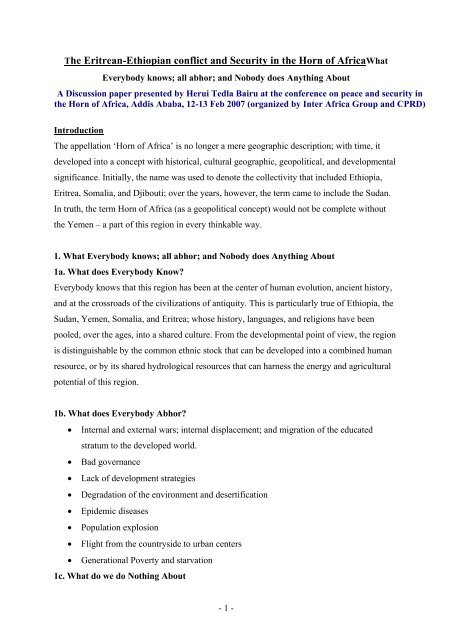The Eritrean-Ethiopian conflict and Security in the Horn of ... - DeQebat
The Eritrean-Ethiopian conflict and Security in the Horn of ... - DeQebat
The Eritrean-Ethiopian conflict and Security in the Horn of ... - DeQebat
Create successful ePaper yourself
Turn your PDF publications into a flip-book with our unique Google optimized e-Paper software.
<strong>The</strong> <strong>Eritrean</strong>-<strong>Ethiopian</strong> <strong>conflict</strong> <strong>and</strong> <strong>Security</strong> <strong>in</strong> <strong>the</strong> <strong>Horn</strong> <strong>of</strong> AfricaWhat<br />
Everybody knows; all abhor; <strong>and</strong> Nobody does Anyth<strong>in</strong>g About<br />
A Discussion paper presented by Herui Tedla Bairu at <strong>the</strong> conference on peace <strong>and</strong> security <strong>in</strong><br />
<strong>the</strong> <strong>Horn</strong> <strong>of</strong> Africa, Addis Ababa, 12-13 Feb 2007 (organized by Inter Africa Group <strong>and</strong> CPRD)<br />
Introduction<br />
<strong>The</strong> appellation ‘<strong>Horn</strong> <strong>of</strong> Africa’ is no longer a mere geographic description; with time, it<br />
developed <strong>in</strong>to a concept with historical, cultural geographic, geopolitical, <strong>and</strong> developmental<br />
significance. Initially, <strong>the</strong> name was used to denote <strong>the</strong> collectivity that <strong>in</strong>cluded Ethiopia,<br />
Eritrea, Somalia, <strong>and</strong> Djibouti; over <strong>the</strong> years, however, <strong>the</strong> term came to <strong>in</strong>clude <strong>the</strong> Sudan.<br />
In truth, <strong>the</strong> term <strong>Horn</strong> <strong>of</strong> Africa (as a geopolitical concept) would not be complete without<br />
<strong>the</strong> Yemen – a part <strong>of</strong> this region <strong>in</strong> every th<strong>in</strong>kable way.<br />
1. What Everybody knows; all abhor; <strong>and</strong> Nobody does Anyth<strong>in</strong>g About<br />
1a. What does Everybody Know?<br />
Everybody knows that this region has been at <strong>the</strong> center <strong>of</strong> human evolution, ancient history,<br />
<strong>and</strong> at <strong>the</strong> crossroads <strong>of</strong> <strong>the</strong> civilizations <strong>of</strong> antiquity. This is particularly true <strong>of</strong> Ethiopia, <strong>the</strong><br />
Sudan, Yemen, Somalia, <strong>and</strong> Eritrea; whose history, languages, <strong>and</strong> religions have been<br />
pooled, over <strong>the</strong> ages, <strong>in</strong>to a shared culture. From <strong>the</strong> developmental po<strong>in</strong>t <strong>of</strong> view, <strong>the</strong> region<br />
is dist<strong>in</strong>guishable by <strong>the</strong> common ethnic stock that can be developed <strong>in</strong>to a comb<strong>in</strong>ed human<br />
resource, or by its shared hydrological resources that can harness <strong>the</strong> energy <strong>and</strong> agricultural<br />
potential <strong>of</strong> this region.<br />
1b. What does Everybody Abhor?<br />
• Internal <strong>and</strong> external wars; <strong>in</strong>ternal displacement; <strong>and</strong> migration <strong>of</strong> <strong>the</strong> educated<br />
stratum to <strong>the</strong> developed world.<br />
• Bad governance<br />
• Lack <strong>of</strong> development strategies<br />
• Degradation <strong>of</strong> <strong>the</strong> environment <strong>and</strong> desertification<br />
• Epidemic diseases<br />
• Population explosion<br />
• Flight from <strong>the</strong> countryside to urban centers<br />
• Generational Poverty <strong>and</strong> starvation<br />
1c. What do we do Noth<strong>in</strong>g About<br />
- 1 -
<strong>The</strong> first question is: are we ready to do someth<strong>in</strong>g about what we know <strong>and</strong> abhor? In this<br />
case, <strong>the</strong> question <strong>of</strong> commitment becomes a primary element <strong>in</strong> our strategic design.<br />
Consistent <strong>and</strong> susta<strong>in</strong>able commitment is possible if civil societies, visionary <strong>in</strong>tellectuals,<br />
<strong>the</strong> market forces, political parties, <strong>and</strong> governments <strong>of</strong> <strong>the</strong> region are galvanized <strong>in</strong>to a<br />
movement for regional union. <strong>The</strong> first step towards such a goal has been taken by <strong>the</strong><br />
organizers <strong>of</strong> this conference; permit me <strong>in</strong> this regard, to thank Inter Africa <strong>and</strong> CPRD for<br />
<strong>in</strong>vit<strong>in</strong>g me to participate to this historic conference.<br />
Politically, <strong>the</strong> ma<strong>in</strong> obstacles are:<br />
<strong>The</strong> nation build<strong>in</strong>g project as an obstacle to a flexible underst<strong>and</strong><strong>in</strong>g <strong>of</strong> sovereignty<br />
Ethnic <strong>and</strong> religious ‘nationalism’ as challenges to <strong>the</strong> creation <strong>of</strong> a regional commonwealth<br />
<strong>The</strong> lack <strong>of</strong> st<strong>and</strong>ardization <strong>of</strong> constitutions <strong>and</strong> auxiliary laws<br />
<strong>The</strong> lack <strong>of</strong> st<strong>and</strong>ardization <strong>of</strong> policy (for example education)<br />
<strong>The</strong> lack <strong>of</strong> <strong>in</strong>stitution-build<strong>in</strong>g st<strong>and</strong>ards (civil <strong>and</strong> military)<br />
Culturally, <strong>the</strong> ma<strong>in</strong> stumbl<strong>in</strong>g blocks are:<br />
Religion as a divisive cultural issue<br />
Language as a mobiliz<strong>in</strong>g cluster <strong>of</strong> symbols represent<strong>in</strong>g civilizational polarities<br />
Economically, <strong>the</strong> ma<strong>in</strong> obstacles are:<br />
<strong>The</strong> absence <strong>of</strong> a regionally accepted currency <strong>and</strong> derivative fiscal policies<br />
<strong>The</strong> lack <strong>of</strong> st<strong>and</strong>ardization <strong>of</strong> taxation laws<br />
<strong>The</strong> immobility <strong>of</strong> peoples, goods, <strong>and</strong> services, <strong>and</strong><br />
A shared strategy regard<strong>in</strong>g <strong>the</strong> issue <strong>of</strong> access to <strong>the</strong> sea.<br />
2. <strong>The</strong> Historical Backdrop to <strong>the</strong> <strong>Eritrean</strong> <strong>Ethiopian</strong> Conflict<br />
Eritrea was <strong>the</strong> first to be decolonized <strong>in</strong> Africa: it was ultimately federated with Ethiopia<br />
after ten years <strong>of</strong> haggl<strong>in</strong>g among <strong>the</strong> victors <strong>of</strong> <strong>the</strong> Second World War. It can be po<strong>in</strong>ted out<br />
that <strong>the</strong> early part <strong>of</strong> <strong>the</strong> <strong>Eritrean</strong> <strong>Ethiopian</strong> federation held <strong>the</strong> promise <strong>of</strong> progress <strong>and</strong> peace,<br />
as it can be po<strong>in</strong>ted out that <strong>the</strong> lack <strong>of</strong> generalization <strong>of</strong> <strong>the</strong> federal pr<strong>in</strong>ciple to all <strong>the</strong><br />
prov<strong>in</strong>ces <strong>of</strong> Ethiopia, <strong>and</strong> <strong>the</strong> abortion <strong>of</strong> <strong>the</strong> said federation, caused <strong>the</strong> long st<strong>and</strong><strong>in</strong>g state<br />
<strong>of</strong> belligerence between <strong>the</strong>se fraternal states.<br />
- 2 -
2a. <strong>The</strong> African Nation Builders<br />
<strong>The</strong> fact that European powers parceled out Africa among <strong>the</strong>mselves (irrespective <strong>of</strong><br />
culturally evolved identity imperatives) is <strong>of</strong>ten presented as an explanation for <strong>the</strong> present<br />
dastardly state <strong>of</strong> our cont<strong>in</strong>ent. This African compla<strong>in</strong>t is only partly true; <strong>the</strong> hard l<strong>in</strong>e<br />
worship <strong>of</strong> ‘territorial <strong>in</strong>tegrity' – that was enshr<strong>in</strong>ed <strong>in</strong> <strong>the</strong> OAU Charter <strong>of</strong> 1963 - was<br />
stipulated by <strong>the</strong> African nation builders <strong>and</strong> not by <strong>the</strong> powers <strong>of</strong> <strong>the</strong> Berl<strong>in</strong> Congress.<br />
<strong>The</strong> elements <strong>of</strong> sovereignty <strong>and</strong> territorial <strong>in</strong>tegrity mutated from <strong>the</strong> elements <strong>of</strong><br />
development <strong>and</strong> welfare to acquire a life <strong>of</strong> <strong>the</strong>ir own to <strong>the</strong> detriment <strong>of</strong> <strong>the</strong> very project <strong>of</strong><br />
nation build<strong>in</strong>g. In o<strong>the</strong>r words, African leaders became <strong>the</strong> gate-keepers <strong>of</strong> sovereignty <strong>and</strong><br />
territorial <strong>in</strong>tegrity at <strong>the</strong> expense <strong>of</strong> development, welfare, <strong>and</strong> democracy.<br />
2b. <strong>The</strong> Emperor’s Nation Build<strong>in</strong>g Project<br />
<strong>The</strong> cont<strong>in</strong>uation <strong>of</strong> <strong>the</strong> <strong>Eritrean</strong> federal solution was considered a direct anti-<strong>the</strong>sis to <strong>the</strong><br />
emperor's unitary nation-build<strong>in</strong>g project. <strong>The</strong> Development Fund <strong>of</strong> <strong>the</strong> nation was denuded<br />
by <strong>the</strong> <strong>in</strong>satiable, ostentatious, consumption habits <strong>of</strong> <strong>the</strong> rul<strong>in</strong>g classes, as well as <strong>the</strong> war<br />
directed at <strong>Eritrean</strong> resistance. In <strong>the</strong> end <strong>the</strong> monarchical system, <strong>and</strong> <strong>the</strong> rickety class<br />
structure over which it sat, was swept away by revolution.<br />
2c. <strong>The</strong> Derg’s Nation Build<strong>in</strong>g Project<br />
<strong>The</strong> Derg saw itself as <strong>the</strong> absolute gate-keeper <strong>of</strong> <strong>the</strong> elements <strong>of</strong> sovereignty <strong>and</strong> territorial<br />
<strong>in</strong>tegrity by virtue <strong>of</strong> its military pr<strong>of</strong>ession, while it neglected <strong>the</strong> elements <strong>of</strong> development,<br />
welfare, <strong>and</strong> democracy <strong>in</strong> <strong>the</strong> package <strong>of</strong> nation build<strong>in</strong>g; <strong>in</strong> addition, it fortified its military<br />
monopoly <strong>of</strong> power by adopt<strong>in</strong>g <strong>the</strong> totalitarian Stal<strong>in</strong>ist ideology. To <strong>the</strong> Derg, <strong>the</strong><br />
emergence <strong>of</strong> <strong>the</strong> Tigrayan revolution, <strong>in</strong> addition to <strong>the</strong> <strong>the</strong>n exist<strong>in</strong>g <strong>Eritrean</strong> revolution,<br />
made <strong>the</strong> ideas <strong>of</strong> development <strong>and</strong> democracy irrelevant. <strong>The</strong> Derg rummaged <strong>in</strong>to <strong>the</strong> Soviet<br />
lexicon <strong>of</strong> nationalities <strong>and</strong> produced <strong>the</strong> tired idea <strong>of</strong> regional autonomy as a solution to <strong>the</strong><br />
armed <strong>conflict</strong>; needless to say, <strong>the</strong> EPLF <strong>and</strong> <strong>the</strong> TPLF did not even stop to consider <strong>the</strong> idea.<br />
<strong>The</strong> two-pronged attack <strong>of</strong> <strong>the</strong> EPLF <strong>and</strong> <strong>the</strong> TPLF aga<strong>in</strong>st <strong>the</strong> Derg resulted <strong>in</strong> <strong>the</strong><br />
<strong>in</strong>dependence <strong>of</strong> Eritrea <strong>and</strong> <strong>the</strong> seizure <strong>of</strong> political power by <strong>the</strong> TPLF <strong>in</strong> Ethiopia.<br />
3. <strong>The</strong> <strong>Eritrean</strong> - <strong>Ethiopian</strong> <strong>conflict</strong><br />
- 3 -
Once aga<strong>in</strong>, Eritrea <strong>and</strong> Ethiopia f<strong>in</strong>d <strong>the</strong>mselves locked <strong>in</strong> a war <strong>of</strong>: “it is ei<strong>the</strong>r me or you”;<br />
let us consider <strong>the</strong> <strong>of</strong>ficial versions <strong>of</strong> <strong>the</strong> <strong>Eritrean</strong> <strong>and</strong> <strong>Ethiopian</strong> governments:<br />
3a. <strong>The</strong> <strong>Eritrean</strong> View <strong>of</strong> <strong>the</strong> Conflict<br />
<strong>The</strong> <strong>Eritrean</strong> government sees <strong>the</strong> <strong>conflict</strong> as a matter <strong>of</strong> accept<strong>in</strong>g <strong>the</strong> decisions <strong>of</strong><br />
<strong>in</strong>ternational arbitration, <strong>and</strong> draw<strong>in</strong>g <strong>the</strong> colonial borders on <strong>the</strong> ground.<br />
3b. <strong>The</strong> <strong>Ethiopian</strong> View <strong>of</strong> <strong>the</strong> Conflict<br />
<strong>The</strong> <strong>Ethiopian</strong> government sees <strong>the</strong> <strong>conflict</strong> as matter <strong>of</strong> sovereignty <strong>and</strong> requires that certa<strong>in</strong><br />
adjustments be made - via negotiations - <strong>in</strong> order to remove <strong>the</strong> causes <strong>of</strong> future tensions.<br />
3c. International Arbitration Versus Face- to-Face Negotiations<br />
<strong>The</strong> boundary question took its present form because both Eritrea <strong>and</strong> Ethiopia decided to<br />
submit <strong>the</strong> border dispute to <strong>in</strong>ternational arbitration. An alternative course could have been<br />
eyeball- to- eyeball negotiations between <strong>the</strong>se two neighbors. An agreement reached via this<br />
diplomatic method could have been presented to <strong>the</strong> relevant UN bodies for <strong>in</strong>ternational<br />
legitimation. This type <strong>of</strong> negotiation, if successful, is known to lead to a reasonably stable<br />
peace, while decisions reached by <strong>in</strong>ternational bodies tend to lead to <strong>the</strong> argument: “you<br />
accepted <strong>the</strong> conditions <strong>of</strong> <strong>the</strong> game will<strong>in</strong>gly, now you need to accept <strong>the</strong> results”.<br />
<strong>The</strong> peace plan <strong>of</strong> <strong>the</strong> <strong>Ethiopian</strong> Prime M<strong>in</strong>ister, Mr. Meles Zenawi, is to be commended<br />
because it rejects war <strong>in</strong> favor <strong>of</strong> negotiations, <strong>and</strong> accepts <strong>the</strong> decisions <strong>of</strong> <strong>the</strong> Border<br />
Commission - <strong>in</strong> pr<strong>in</strong>ciple - lead<strong>in</strong>g to mutual corrections <strong>of</strong> sticky issues.<br />
<strong>The</strong> question is: with whom is <strong>the</strong> Five Po<strong>in</strong>t Plan to be negotiated? With Afewerki? Even if it<br />
is argued that <strong>the</strong> <strong>Eritrean</strong> dictator is will<strong>in</strong>g to accept <strong>the</strong> <strong>Ethiopian</strong> <strong>of</strong>fer, it is doubtful that<br />
<strong>the</strong> results would secure a peaceful future. Prelim<strong>in</strong>ary negotiations may be made with<br />
genu<strong>in</strong>e representatives <strong>of</strong> <strong>Eritrean</strong>s liv<strong>in</strong>g outside Eritrea; after all, approximately half <strong>of</strong> <strong>the</strong><br />
<strong>Eritrean</strong> people live abroad. <strong>The</strong> first step towards this objective may be to help establish a<br />
caretaker <strong>Eritrean</strong> government (<strong>in</strong> exile). Such a government supported by <strong>the</strong> Sana’a Forum<br />
<strong>and</strong> <strong>the</strong> IGAD may show surpris<strong>in</strong>g results.<br />
- 4 -
4. Steps Towards Peace<br />
<strong>The</strong> discussion regard<strong>in</strong>g <strong>the</strong> elements <strong>of</strong> nation build<strong>in</strong>g (made above) is not an argument <strong>in</strong><br />
favor <strong>of</strong> <strong>the</strong> demise <strong>of</strong> sovereignty <strong>and</strong> territorial <strong>in</strong>tegrity. It simply raises <strong>the</strong> question <strong>of</strong><br />
what <strong>the</strong> elements <strong>of</strong> sovereignty <strong>and</strong> territorial <strong>in</strong>tegrity would look like seen from <strong>the</strong><br />
perspective <strong>of</strong> democracy, development, <strong>and</strong> welfare? <strong>The</strong> confederal formula is presented as<br />
a possible solution to <strong>the</strong> long st<strong>and</strong><strong>in</strong>g <strong>conflict</strong> between Ethiopia <strong>and</strong> Eritrea. Confederation<br />
understood as a political association <strong>of</strong> sovereign states, where <strong>the</strong>se states surrender parts <strong>of</strong><br />
<strong>the</strong>ir sovereignties to a higher confederal sovereignty, tends to be economically backbreak<strong>in</strong>g<br />
as it may be fraught with ethnic <strong>and</strong> religious m<strong>in</strong>efields. Fur<strong>the</strong>rmore, for <strong>the</strong> confederal<br />
solution to succeed, it needs to be generalized to <strong>the</strong> whole <strong>of</strong> Ethiopia - so that it may not die<br />
<strong>the</strong> pa<strong>in</strong>ful death <strong>of</strong> <strong>the</strong> <strong>Eritrean</strong>-<strong>Ethiopian</strong> federation.<br />
4a. <strong>The</strong> Coal <strong>and</strong> Steel model<br />
<strong>The</strong> alternative may lie <strong>in</strong> Eritrea <strong>and</strong> Ethiopia develop<strong>in</strong>g a political space to be developed<br />
jo<strong>in</strong>tly. <strong>The</strong> coal <strong>and</strong> steel model that led to <strong>the</strong> European Union may be applied <strong>in</strong> resolv<strong>in</strong>g<br />
<strong>the</strong> issue <strong>of</strong> ‘access to <strong>the</strong> sea’ as a shared resource. <strong>The</strong> need to discuss Assab as a jo<strong>in</strong>t<br />
project between Eritrea Ethiopia - on <strong>the</strong> basis <strong>of</strong> equal partnership - grounded upon an<br />
<strong>in</strong>ternationally guaranteed corporate, juridical, personality, may open up a dialogue that may<br />
benefit all concerned.<br />
Ano<strong>the</strong>r bone <strong>of</strong> contention is Ali Tena <strong>and</strong> its environs. <strong>Eritrean</strong>s are sensitive to <strong>the</strong> fact that<br />
this area leads to <strong>the</strong> Red Sea port <strong>of</strong> Arefaile via a canyon that is hard to defend. Even here,<br />
<strong>the</strong> ‘coal <strong>and</strong> steel model’ may be applied for <strong>the</strong> jo<strong>in</strong>t benefit <strong>of</strong> Eritrea <strong>and</strong> Ethiopia.<br />
Even <strong>the</strong> Badume <strong>conflict</strong> may be resolved with<strong>in</strong> <strong>the</strong> framework <strong>of</strong> cooperation <strong>in</strong> <strong>the</strong><br />
Tekezie-Setit hydrological bas<strong>in</strong>.<br />
4b. Redesign<strong>in</strong>g <strong>the</strong> Concept <strong>of</strong> Sovereignty<br />
• <strong>The</strong> establishment <strong>of</strong> constitutional, civil, democratic, state <strong>of</strong> rights may be a pragmatic<br />
step to be pursued.<br />
• <strong>The</strong> replacement <strong>of</strong> <strong>the</strong> s<strong>in</strong>gle party by a multi-party system may help <strong>in</strong> enhanc<strong>in</strong>g peace<br />
<strong>and</strong> security.<br />
- 5 -
• <strong>The</strong> concepts <strong>of</strong> ‘sovereignty’ <strong>and</strong> ‘territorial <strong>in</strong>tegrity’ may need to be redesigned <strong>in</strong> order<br />
to accommodate <strong>the</strong> Coal <strong>and</strong> Steel Model <strong>and</strong> <strong>the</strong> political space that may ensue from it.<br />
• <strong>The</strong> concept <strong>of</strong> external sovereignty needs to be divested <strong>of</strong> its exclusivist significance <strong>in</strong><br />
order to encourage regional union.<br />
- 6 -



